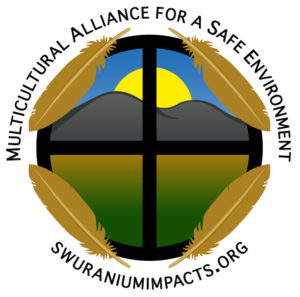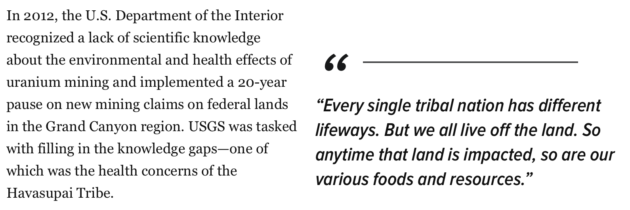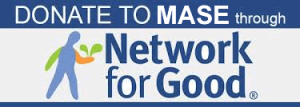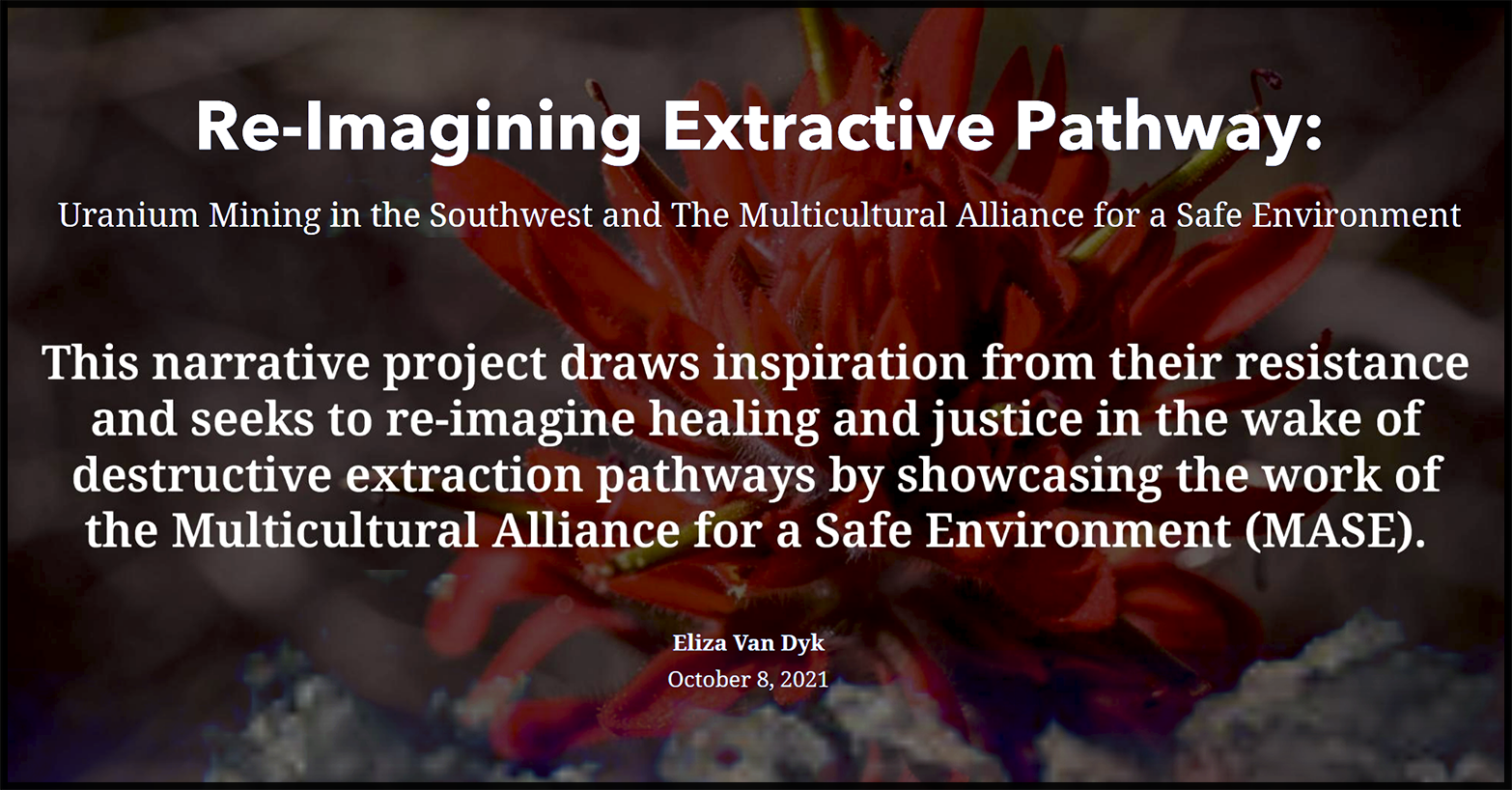Ignored Paths of Uranium Exposure Illuminated by Havasupai Tribe
An agency-tribal partnership is identifying exposure risks previously not considered in mining risk assessments.
Carletta Tilousi has seen multiple friends and family members suffer from cancer. “Everyone’s lost loved ones,” she said. “But we’re not yet sure where it’s coming from. Is it in the air? In the water? We just don’t know.”
In particular, Tilousi and fellow members of the Havasupai Tribe are concerned about their potential exposure to uranium and uranium mining by-products as a result of mining operations around the Grand Canyon, where Havasupai ancestral lands are located and many tribal members live.
Now, the Havasupai Tribe’s concerns about their members’ health, safety, and lifeways are included in a federal risk framework as part of efforts by the U.S. Geological Survey (USGS) and the U.S. Department of the Interior to better understand the potential impacts of uranium mining on human health.
“This reaffirmed a lot of things that my family and my community are going through,” said Tilousi, who is the lead author on the risk framework and a former Havasupai tribal council member. The framework could help inform risk assessments for future uranium mines.
Ignored Exposures
Uranium mining has been ongoing in the Grand Canyon region since the 1940s. The practice is known to elevate the risk of lung cancer and kidney problems among miners and nearby residents, and exposure to metal by-products such as arsenic and nickel is linked to many types of cancer, as well as respiratory and neurological problems.
The nearby Navajo Nation, for example, had many community members working and living near mines who experienced elevated rates of lung cancer and other health issues tied to the uranium mining boom. Cancer rates linked to uranium mining among the Havasupai have not been tracked as they have for the Navajo Nation.
“Every single tribal nation has different lifeways. But we all live off the land. So anytime that land is impacted, so are our various foods and resources.”
In 2012, the U.S. Department of the Interior recognized a lack of scientific knowledge about the environmental and health effects of uranium mining and implemented a 20-year pause on new mining claims on federal lands in the Grand Canyon region. USGS was tasked with filling in the knowledge gaps—one of which was the health concerns of the Havasupai Tribe.
Through collaborative research with Havasupai community members, Tilousi and Jo Ellen Hinck, an author on the framework and a biologist at USGS, identified multiple previously disregarded pathways through which Havasupai community members might be exposed to uranium or uranium mining by-products such as arsenic, nickel, and copper.
“Every single tribal nation has different lifeways. But we all live off the land. So anytime that land is impacted, so are our various foods and resources,” said Laurie Suter, a member of the National Tribal Toxics Council, a partnership with EPA designed to elevate tribal perspectives in federal decisionmaking on toxics. Suter was not involved in the new framework.
Havasupai lifeways involve gathering plants and animals from the land, which may contain uranium or metals. Many Havasupai ceremonies also involve close interactions with plants and animals, increasing the risk of exposure via inhalation, ingestion, and skin contact. Traditional deer hide processing, for instance, includes close contact with deer organs and fluids, and medicinal and ceremonial use of plants such as big sagebrush and Utah juniper is common.
A new contaminant exposure framework for uranium mining includes a Havasupai perspective. Credit: USGS/Blake McCord/Dawn Beauty
Such exposure pathways have been historically disregarded because they’re different from those that nontribal people experience in their daily lives, Hinck said. The framework doesn’t quantify the actual exposures posed by specific mining projects, she said. “This framework is saying that these pathways are important to consider. They haven’t been considered in the past, and that could be a future research direction.”
Perspectives and Partnership
The partnership between USGS and the Havasupai Tribe took years to develop. In 2012, when USGS was first asked to research gaps in knowledge of exposure pathways, Hinck and her colleagues were in their “comfort zone,” she said, completing technological studies on the fate and transport of contaminants.
But as they presented their results to nearby communities, including the Havasupai tribal council, they realized they needed to better consider the tribe’s wealth of knowledge of nearby plants and animals, as well as tribal concerns about exposure.
“That was important for me as a tribal leader: to see the consistency and commitment.”
The partnership’s success, from Tilousi’s perspective, was due to USGS scientists, particularly Hinck, following through on their agreements to share information with the tribe. “That was important for me as a tribal leader,” Tilousi said. “To see the consistency and commitment.” The resulting framework is a “great example” of a partnership between a federal agency and a tribe, Suter said.
The research didn’t just codify exposure pathways; it also documented important information about plants, animals, and the Havasupai language, Tilousi said. “That’s what really intrigued me,” she said, “documenting it, leaving it for the children and the next generation to understand that this is what sustained our people and can continue to sustain our people if we protect it.”
Tilousi and Hinck are working to develop educational materials for Havasupai teachers to communicate the findings of the framework to students. Tilousi said she hopes the framework will provide an example to other tribes of how to document their own exposure pathways. “That would be the best thing,” she said.
—Grace van Deelen (@GVD__), Staff Writer
Citation: Van Deelen, G. (2024), Ignored paths of uranium exposure illuminated by Havasupai Tribe, Eos, 105, https://doi.org/10.1029/2024EO240079. Published on 20 February 2024.
Text © 2024. AGU. CC BY-NC-ND 3.0






